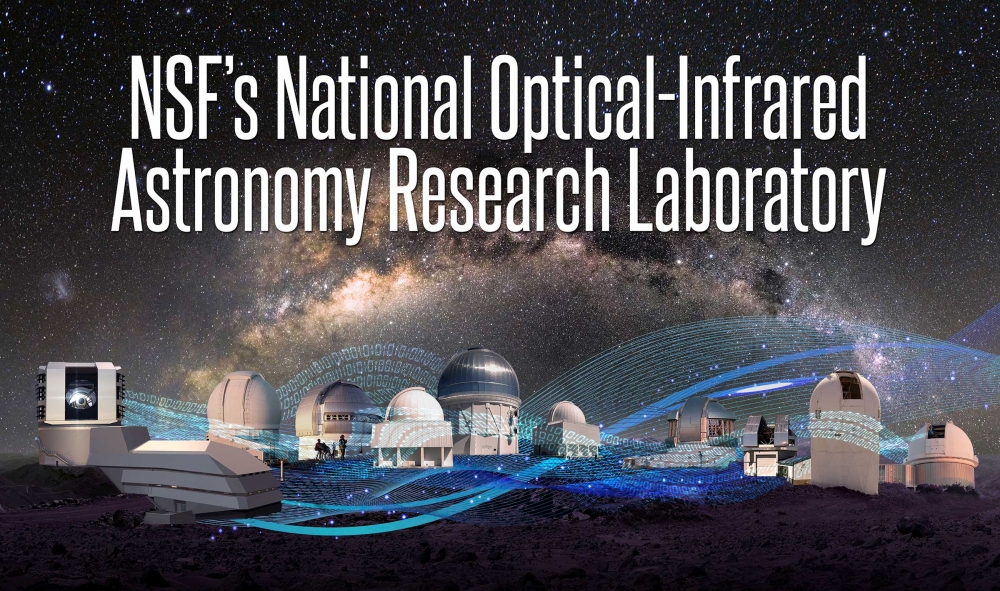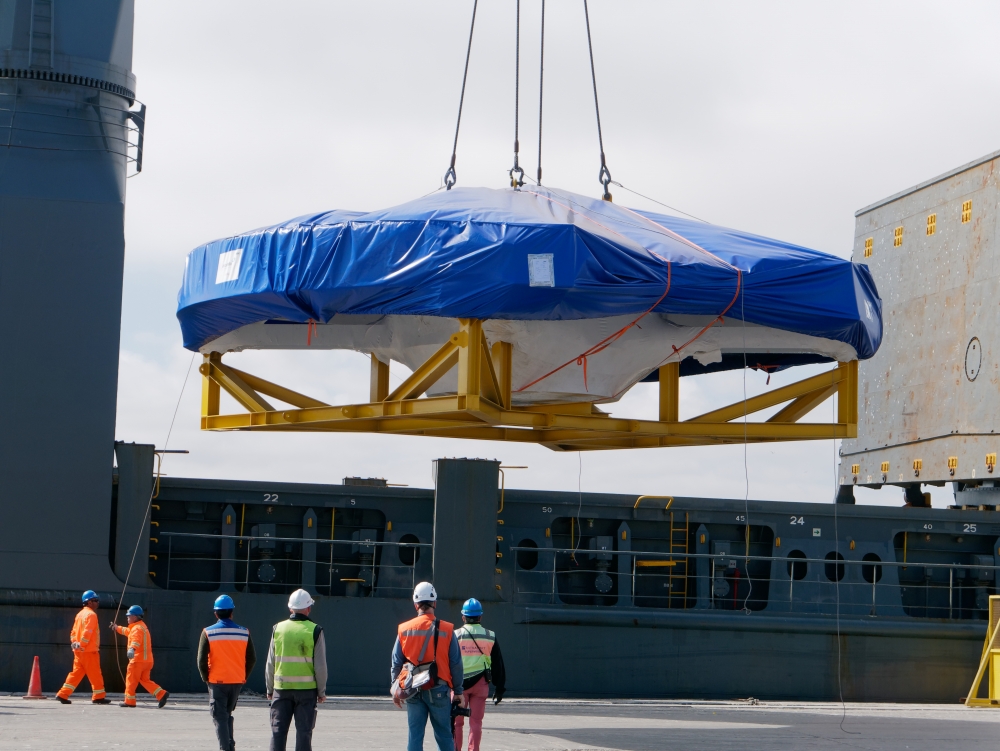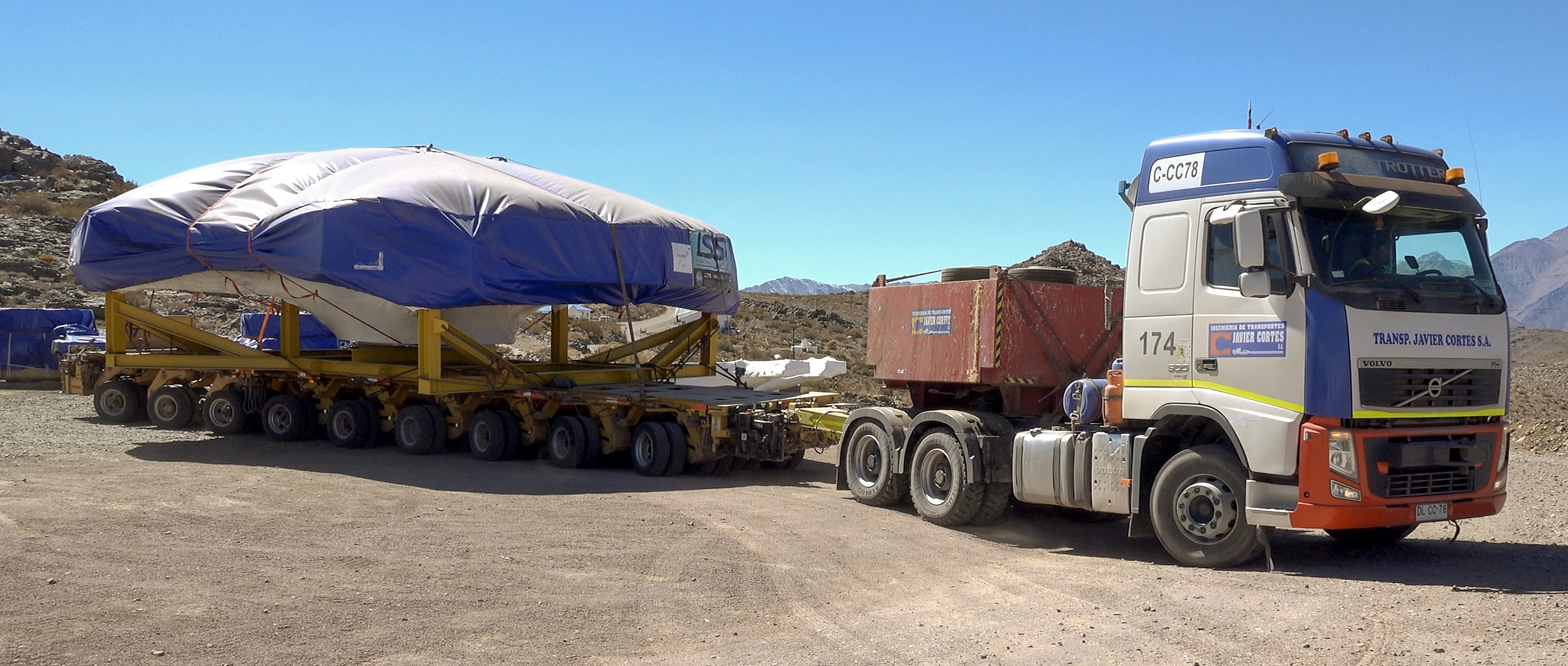Our thoughts are with our Chile-based colleagues during the recent period of social instability. All LSST staff and their families, as well as contractors and visitors, are safe, and we have stayed in frequent contact with them since the unrest in Chile began.
A team from EIE Group and Phase Motion Control has arrived on the summit to start up and test the LSST Dome azimuth drives. As of last week, the bogies had undergone final alignment, installation/connection of drives was complete, and the dome was successfully rotating under power with a provisional friction drive system in place of the final rack-and-piñon system. A short video of the dome rotating is available at this link.
The carousel and back flange of the LSST filter exchange system, which were recently transported by plane from Paris, France, have safely arrived at SLAC National Accelerator Laboratory in Menlo Park, CA. The back flange has now been fitted to the camera body—these are the two largest pieces of the camera assembly—for early metrology activities.
As part of the LSST survey strategy optimization effort, a new series of simulated surveys has been released; the full announcement is available at this link. There will be further discussion of these simulations and their trade-offs on community.lsst.org. Log in and make your voice heard!
National Science Foundation (NSF) Director France Cordova and Department of Energy (DOE) Undersecretary for Science Paul Dabbar visited La Serena and the LSST summit construction site on October 18th and 19th. It was a quiet day on the summit, as dome bogie alignment was in progress, but the visit was a great opportunity to see the accomplishments at the base facility and the summit. Both indicated being highly impressed with the evident progress.
The Data Management (DM) team will facilitate 2019 DM Boot Camp in Princeton, New Jersey, on November 12-14. Tutorials and lectures will be lead by current DM team members, and will be geared towards the new scientists who have joined the Data Release Pipelines (DRP) team, but attendance is open to everyone. More details, including remote streaming information, are available at this link.
PERSONNEL NEWS
Clare Saunders and Arun Kannawadi joined the Data Management group as Data Release Pipelines (DRP) Software Scientists on October 15th. Based at Princeton, Clare and Arun will be developing the Data Release Science Pipelines for LSST.
George Gomez joined the Education and Public Outreach (EPO) team in the role of Web Developer on October 21st. George will contribute to EPO’s mission by building web-based interactive tools and visualizations for use in classrooms and by the general public, with special consideration for accessibility and mobile platforms.
Jeff Carlin was promoted from his current position as Precursor Science Postdoc to a new role as Science Validation Scientist, effective September 29th. In this role, Jeff will plan and execute acceptance test campaigns to verify that DM products meet the requirements laid out in the DM Science Requirements Document. Additionally, he will work with the science community to conduct validation campaigns to ensure that the DM systems are enabling the science LSST was designed to accomplish.
UPCOMING MEETINGS with LSST INVOLVEMENT
(those with asterisk* are LSSTC funded):
2019 | |
November 6-8 | Kavli Petabytes to Science Data Inclusion Revolution Workshop, Boston, MA |
November 12-14 | Data Management Boot Camp 2019, |
December 9-10 | Towards Science in Chile with LSST 2019, Concepción, Chile* |
2020 | |
January 4-8 | American Astronomical Society (AAS) 235th Meeting, Honolulu, HI |
January 22-23 | AMCL Meeting, SLAC, CA |
March 17-19 | LSST Algorithms Workshop, Princeton, NJ |
NOTICIAS DEL PROYECTO Y LA CIENCIA
Nuestros pensamientos están con nuestros colegas con en Chile durante el reciente período de inestabilidad social. Todo el personal de LSST y sus familias, así como los contratistas y visitantes, están a salvo, y nos hemos mantenido en contacto frecuente con ellos desde que comenzaron los disturbios en Chile.
Un equipo de EIE Group y Phase Motion Control llegó al sitio para iniciar y probar las unidades de acimut del Domo de LSST. La semana pasada, los bogies se sometieron a una alineación final, se completó la instalación/conexión de los accionamientos y el domo giraba con éxito bajo energía con un sistema de accionamiento de fricción provisional en lugar del sistema final de rack y piñón. Un video corto de la rotación del domo está disponible en este enlace link.
El carrusel y la brida trasera del sistema de intercambio de filtros LSST, los cuales fueron transportados recientemente en avión desde París, Francia, llegaron seguros al Laboratorio Nacional de Aceleradores SLAC en Menlo Park, CA. La brida trasera ahora se ha instalado en el cuerpo de la cámara – estas son las dos piezas más grandes del conjunto de la cámara – para las primeras actividades de metrología.
Como parte del esfuerzo de optimización de la estrategia de estudios de LSST, se ha lanzado una nueva serie de estudios simulados; El anuncio completo está disponible en este enlace link. Habrá más discusión sobre estas simulaciones y sus compensaciones en community.lsst.org. Inicia sesión y haz que se escuche tu voz!
El Director de la Fundación Nacional de Ciencias (NSF), France Cordova y el Subsecretario de Ciencias del Departamento de Energía (DOE), Paul Dabbar, visitaron La Serena y el sitio de construcción de LSST los días 18 y 19 de octubre. Fue un día tranquilo en el sitio, ya que la alineación del bogie de la cúpula estaba en progreso, pero la visita fue una gran oportunidad para ver los logros en el Base Facility y en el cerro. Ambos indicaron estar muy impresionados con el progreso evidente.
El equipo de Gestión de Datos (DM) llevara a cabo el DM Boot Camp 2019 en Princeton, Nueva Jersey, del 12 al 14 de noviembre. Los tutoriales y conferencias serán dirigidos por los miembros actuales del equipo de DM y estarán orientados a los nuevos científicos que se han unido al equipo de Data Release Pipelines (DRP), pero la asistencia está abierta para todos. Más detalles, incluyendo la información de transmisión remota, están disponibles en este enlace link.
NOTICIAS DE PERSONAL
Clare Saunders y Arun Kannawadi se unieron al grupo de Gestión de Datos como Científicos en Software de Pipelines de Liberación de Datos (DRP) el 15 de octubre. Con base en Princeton, Clare y Arun desarrollarán los Pipelines de Liberación de Datos Científicos para LSST.
George Gómez se unió al equipo de Educación y Difusión Pública (EPO) en el rol de Desarrollador Web el 21 de octubre. George contribuirá a la misión de EPO mediante la creación de herramientas y visualizaciones interactivas basadas en la web para su uso en las aulas y por el público en general, con especial consideración en la accesibilidad y plataformas móviles.
Jeff Carlin fue promovido de su puesto actual como Precursor Science Postdoc a un nuevo puesto de Científico de Validación de Ciencias, el 29 de septiembre. En este rol, Jeff planificará y ejecutará campañas de prueba de aceptación para verificar que los productos DM cumplan con los requisitos establecidos en el Documento de Requisitos Científicos de DM. Además, trabajará con la comunidad científica para llevar a cabo campañas de validación para garantizar que los sistemas DM estén habilitando la ciencia que LSST fue diseñada para lograr.
PRÓXIMAS REUNIONES con PARTICIPACIÓN LSST
(aquellas con asterisco * están financiadas por LSSTC ):
2019 | |
6-8 de Noviembre | Taller Kavli Petabytes to Science Data Inclusion Revolution, Boston, MA |
12-14 de Noviembre | Data Management Boot Camp 2019, |
9-10 de Diciembre | Towards Science in Chile with LSST 2019, Concepción, Chile* |
2020 | |
4-8 de Enero | American Astronomical Society (AAS) 235th Meeting, Honolulu, HI |
22-23 de Enero | Reunion AMCL, SLAC, CA |
17-19 de Marzo | LSST Algorithms Workshop, Princeton, NJ |







